Quantitative Assessment of Agricultural Drought Risk in Southeast Gansu Province, Northwest China
Abstract
1. Introduction
2. Data and Methodology
2.1. Study Area
2.2. Data
2.3. Methodology
2.3.1. Calculation of ET0
2.3.2. Calculation of the SPEI
2.3.3. The Mann–Kendall Test for Trend Analysis
2.3.4. Assessment of Agricultural Drought Hazards
2.3.5. Assessment of Agricultural Drought Vulnerability
Climate
Geographic Features
Soil
Irrigation
Economic Conditions
2.3.6. Assessment of Agricultural Drought Hazards
3. Results
3.1. Changes in the Annual SPEI and Climatic Factors
3.2. Spatial Distribution of the SPEI and Climatic Driving Factors
3.3. Agricultural Drought Risk Assessment
3.3.1. Agricultural Drought Hazard in Southeast Gansu Province
3.3.2. Agricultural Drought Vulnerability in Southeast Gansu Province
3.4. Agricultural Drought Risk in Southeast Gansu Province
4. Discussion
4.1. Attributions and Implications of Changes in ET0
4.2. Spatial Patterns of and Influencing Factors in Agricultural Drought Risk in SEG
4.3. Mitigation of and Adaptation to Future Agricultural Drought Risk in SEG
4.4. A Framework for Drought Risk Assessment
5. Conclusions
Author Contributions
Funding
Conflicts of Interest
References
- Yu, M.; Li, Q.; Hayes, M.J.; Svoboda, M.D.; Heim, R.R. Are droughts becoming more frequent or severe in China based on the standardized precipitation evapotranspiration index: 1951–2010. Int. J. Clim. 2014, 34, 545–558. [Google Scholar] [CrossRef]
- Dai, A. Characteristics and trends in various forms of the Palmer Drought Severity Index during 1900–2008. J. Geophys. Res. Atmosph. 2011, 116. [Google Scholar] [CrossRef]
- Yao, Y.; Dong, A.; Wang, Y.; Zhang, X.; Yang, J. Compare research of the regional arid characteristic base on Palmer drought severity index in spring over China. Arid Land Geogr. 2007, 30, 22–29. (In Chinese) [Google Scholar]
- Rezaei, E.E.; Webber, H.; Gaiser, T.; Naab, J.; Ewert, F. Heat stress in cereals: Mechanisms and modelling. Eur. J. Agron. 2015, 64, 98–113. [Google Scholar] [CrossRef]
- Sheffield, J.; Wood, E.F.; Roderick, M.L. Little change in global drought over the past 60 years. Nature 2012, 491, 435–438. [Google Scholar] [CrossRef] [PubMed]
- Welle, T.; Birkmann, J. The World Risk Index–An approach to assess risk and vulnerability on a global scale. J. Extreme Event 2015, 2, 1550003. [Google Scholar] [CrossRef]
- UNISDR (United Nations International Strategy for Disaster Reduction). Living with Risk: A Global Review of Disaster Reduction Initiatives; United Nations Publications: Geneva, Switzerland, 2004; Volume 1. [Google Scholar]
- IPCC (Intergovernmental Panel on Climate Change). Managing the Risks of Extreme Events and Disasters to Advance Climate Change Adaptation; A Special Report of Working Groups I and II of the Intergovernmental Panel on Climate Change; Field, C., Barros, V., Stocker, T., Qin, D., Dokken, D., Ebi, K., Mastrandrea, M., Mach, K., Plattner, G.-K., Allen, S., Eds.; Cambridge University Press: Cambridge, UK; New York, NY, USA, 2012; Volume 30, pp. 7575–7613. [Google Scholar]
- Vicente-Serrano, S.M.; Begueria, S.; Lorenzo-Lacruz, J.; Julio Camarero, J.; Lopez-Moreno, J.I.; Azorin-Molina, C.; Revuelto, J.; Moran-Tejeda, E.; Sanchez-Lorenzo, A. Performance of Drought Indices for Ecological, Agricultural, and Hydrological Applications. Earth Interact. 2012, 16. [Google Scholar] [CrossRef]
- McKee, T.B.; Doesken, N.J.; Kleist, J. The relationship of drought frequency and duration to time scales. In Proceedings of the 8th Conference on Applied Climatology, Anaheim, CA, USA, 17–22 January 1993; pp. 179–183. [Google Scholar]
- Vicente-Serrano, S.M.; Beguería, S.; López-Moreno, J.I. A multiscalar drought index sensitive to global warming: The standardized precipitation evapotranspiration index. J. Clim. 2010, 23, 1696–1718. [Google Scholar] [CrossRef]
- Shahid, S.; Behrawan, H. Drought risk assessment in the western part of Bangladesh. Nat. Hazards 2008, 46, 391–413. [Google Scholar] [CrossRef]
- He, B.; Wu, J.; Lu, A.; Cui, X.; Zhou, L.; Liu, M.; Zhao, L. Quantitative assessment and spatial characteristic analysis of agricultural drought risk in China. Nat. Hazards 2013, 66, 155–166. [Google Scholar] [CrossRef]
- Kim, H.; Park, J.; Yoo, J.; Kim, T.-W. Assessment of drought hazard, vulnerability, and risk: A case study for administrative districts in South Korea. J. Hydro-Environ. Res. 2015, 9, 28–35. [Google Scholar] [CrossRef]
- Pei, W.; Fu, Q.; Liu, D.; Li, T.-x.; Cheng, K.; Cui, S. Spatiotemporal analysis of the agricultural drought risk in Heilongjiang Province, China. Theor. Appl. Climatol. 2018, 133, 151–164. [Google Scholar] [CrossRef]
- Zhang, Q.; Sun, P.; Li, J.; Xiao, M.; Singh, V.P. Assessment of drought vulnerability of the Tarim River basin, Xinjiang, China. Theor. Appl. Climatol. 2015, 121, 337–347. [Google Scholar] [CrossRef]
- Roderick, M.L.; Rotstayn, L.D.; Farquhar, G.D.; Hobbins, M.T. On the attribution of changing pan evaporation. Geophys. Res. Lett. 2007, 34. [Google Scholar] [CrossRef]
- Thornthwaite, C.W. An approach toward a rational classification of climate. Geogr. Rev. 1948, 38, 55–94. [Google Scholar] [CrossRef]
- Hobbins, M.T.; Dai, A.; Roderick, M.L.; Farquhar, G.D. Revisiting the parameterization of potential evaporation as a driver of long-term water balance trends. Geophys. Res. Lett. 2008, 35. [Google Scholar] [CrossRef]
- Zhai, L.; Feng, Q. Spatial and temporal pattern of precipitation and drought in Gansu Province, Northwest China. Nat. Hazards 2009, 49, 1–24. [Google Scholar] [CrossRef]
- Yin, X.; Deng, Z.; Xu, Q.; Dong, A. Study on drought disasters in Gansu province since recent 50 years. Arid Zone Res. 2005, 22, 120–124. [Google Scholar]
- Allen, R.G.; Pereira, L.S.; Raes, D.; Smith, M. Crop evapotranspiration-Guidelines for computing crop water requirements-FAO Irrigation and drainage paper 56. Fao Rome 1998, 300, D05109. [Google Scholar]
- Ji, L.; Peters, A.J. Assessing vegetation response to drought in the northern Great Plains using vegetation and drought indices. Remote Sens. Environ. 2003, 87, 85–98. [Google Scholar] [CrossRef]
- Gocic, M.; Trajkovic, S.J.G. Analysis of changes in meteorological variables using Mann-Kendall and Sen’s slope estimator statistical tests in Serbia. Glob. Plan. Chang. 2013, 100, 172–182. [Google Scholar] [CrossRef]
- Sa’adi, Z.; Shahid, S.; Ismail, T.; Chung, E.-S.; Wang, X.-J.J.M. Trends analysis of rainfall and rainfall extremes in Sarawak, Malaysia using modified Mann–Kendall test. Metereol. Atmosph. Phys. 2019, 131, 263–277. [Google Scholar] [CrossRef]
- Sonmez, F.K.; Komuscu, A.U.; Erkan, A.; Turgu, E. An analysis of spatial and temporal dimension of drought vulnerability in Turkey using the standardized precipitation index. Nat. Hazards 2005, 35, 243–264. [Google Scholar] [CrossRef]
- Smith, R.M. Comparing traditional methods for selecting class intervals on choropleth maps. Prof. Geogr. 1986, 38, 62–67. [Google Scholar] [CrossRef]
- Wu, J.; He, B.; Lu, A.; Zhou, L.; Liu, M.; Zhao, L. Quantitative assessment and spatial characteristics analysis of agricultural drought vulnerability in China. Nat. Hazards 2011, 56, 785–801. [Google Scholar] [CrossRef]
- Cutter, S.L.; Finch, C. Temporal and spatial changes in social vulnerability to natural hazards. Proc. Natl. Acad. Sci. USA 2008, 105, 2301–2306. [Google Scholar] [CrossRef] [PubMed]
- Birkmann, J.; Cardona, O.D.; Carreño, M.L.; Barbat, A.H.; Pelling, M.; Schneiderbauer, S.; Kienberger, S.; Keiler, M.; Alexander, D.; Zeil, P. Framing vulnerability, risk and societal responses: The MOVE framework. Nat. Hazards 2013, 67, 193–211. [Google Scholar] [CrossRef]
- Xu, X.; Liu, J.; Cao, M.; Zhang, S. Impact of recent climate fluctuation and LUCC process on potential productivity for crops in northeast China. Sci. Geogr. Sin. 2007, 27, 318–324. (In Chinese) [Google Scholar]
- Wilhelmi, O.V.; Wilhite, D.A. Assessing vulnerability to agricultural drought: A Nebraska case study. Nat. Hazards 2002, 25, 37–58. [Google Scholar] [CrossRef]
- Parry, M.L.; Carter, T. The effect of climatic variations on agricultural risk. Impact Clim. Var. Agric. 1985, 7, 95–110. [Google Scholar] [CrossRef]
- Zhou, W.; Liu, G.; Pan, J. Distribution of available soil water capacity in China. J. Geogr. Sci. 2005, 15, 3–12. (In Chinese) [Google Scholar] [CrossRef]
- Reynolds, C.; Jackson, T.; Rawls, W.J. Estimating soil water-holding capacities by linking the FAO soil map of the world with global soil profile databases and pedo-transfer functions. Surf. Water Clim. 2000. [Google Scholar] [CrossRef]
- Saxton, K.E.; Rawls, W.J. Soil water characteristic estimates by texture and organic matter for hydrologic solutions. Soil Sci. Soc. Am. J. 2006, 70, 1569–1578. [Google Scholar] [CrossRef]
- Batjes, N.H. Development of a world data set of soil water retention properties using pedotransfer rules. Geoderma 1996, 71, 31–52. [Google Scholar] [CrossRef]
- Zaveri, E.; Lobell, D.B. The role of irrigation in changing wheat yields and heat sensitivity in India. Nat. Commun. 2019, 10, 1–7. [Google Scholar] [CrossRef]
- Fischer, G.; Tubiello, F.N.; Van Velthuizen, H.; Wiberg, D.A. Climate change impacts on irrigation water requirements: Effects of mitigation, 1990–2080. Tech. Forecast. Soc. Chang. 2007, 74, 1083–1107. [Google Scholar] [CrossRef]
- Burke, M.; Lobell, D. Food security and adaptation to climate change: What do we know. In Climate Change and Food Security; Springer: Berlin, Germany, 2010; pp. 133–153. [Google Scholar]
- Simelton, E.; Fraser, E.D.G.; Termansen, M.; Forster, P.M.; Dougill, A.J. Typologies of crop-drought vulnerability: An empirical analysis of the socio-economic factors that influence the sensitivity and resilience to drought of three major food crops in China (1961–2001). Environ. Sci. Policy 2009, 12, 438–452. [Google Scholar] [CrossRef]
- Yang, X.; Lin, E.; Ma, S.; Ju, H.; Guo, L.; Xiong, W.; Li, Y.; Xu, Y. Adaptation of agriculture to warming in Northeast China. Clim. Chang. 2007, 84, 45–58. [Google Scholar] [CrossRef]
- Wang, Z.; Xie, P.; Lai, C.; Chen, X.; Wu, X.; Zeng, Z.; Li, J. Spatiotemporal variability of reference evapotranspiration and contributing climatic factors in China during 1961–2013. J. Hydrol. 2017, 544, 97–108. [Google Scholar] [CrossRef]
- Jhajharia, D.; Dinpashoh, Y.; Kahya, E.; Singh, V.P.; Fakheri-Fard, A. Trends in reference evapotranspiration in the humid region of northeast India. Hydrol. Proc. 2012, 26, 421–435. [Google Scholar] [CrossRef]
- Moonen, A.; Ercoli, L.; Mariotti, M.; Masoni, A. Climate change in Italy indicated by agrometeorological indices over 122 years. Agric. Forest Meteorol. 2002, 111, 13–27. [Google Scholar] [CrossRef]
- Roderick, M.L.; Farquhar, G.D.J.I.J.o.C.A.J.o.t.R.M.S. Changes in New Zealand pan evaporation since the 1970s. Int. J. Clim. J. R. Meteorol. Soc. 2005, 25, 2031–2039. [Google Scholar] [CrossRef]
- Rayner, D.P. Wind run changes: The dominant factor affecting pan evaporation trends in Australia. J. Clim. 2007, 20, 3379–3394. [Google Scholar] [CrossRef]
- Golubev, V.S.; Lawrimore, J.H.; Groisman, P.Y.; Speranskaya, N.A.; Zhuravin, S.A.; Menne, M.J.; Peterson, T.C.; Malone, R.W. Evaporation changes over the contiguous United States and the former USSR: A reassessment. Geophys. Res. Lett. 2001, 28, 2665–2668. [Google Scholar] [CrossRef]
- Yin, Y.; Wu, S.; Dai, E. Determining factors in potential evapotranspiration changes over China in the period 1971–2008. Chin. Sci. Bull. 2010, 55, 3329–3337. [Google Scholar] [CrossRef]
- Fan, Z.-X.; Thomas, A. Spatiotemporal variability of reference evapotranspiration and its contributing climatic factors in Yunnan Province, SW China, 1961–2004. Clim. Chang. 2013, 116, 309–325. [Google Scholar] [CrossRef]
- Bolin, R.; Stanford, L. The Northridge earthquake: Community-based approaches to unmet recovery needs. Disasters 1998, 22, 21–38. [Google Scholar] [CrossRef] [PubMed]
- Adger, W.N.; Kelly, P.M. Social vulnerability to climate change and the architecture of entitlements. Mitig. Adapt. Strat. Glob. Chang. 1999, 4, 253–266. [Google Scholar] [CrossRef]
- Sun, C.; Yang, S. Persistent severe drought in southern China during winter-spring 2011: Large-scale circulation patterns and possible impacting factors. J. Geophys. Res. Atmos. 2012, 117. [Google Scholar] [CrossRef]
- Zhang, C.; Xie, J.; Li, D.; Guo, H. Effect of east-Asian monsoon on drought climate of northwest China. Plateau Meteorol. 2002, 21, 193–198. (In Chinese) [Google Scholar]
- Wang, Y.; Cao, M.; Tao, B.; Li, K. The characteristics of spatio-temporal patterns in precipitation in China under the background of global climate change. Geogr. Res. 2006, 25, 1031–1040. (In Chinese) [Google Scholar]
- Song, L.; Zhang, C. Changing features of precipitation over nothwest China during the 20th century. J. Glaciol. Geocryol. 2003, 25, 143–148. (In Chinese) [Google Scholar]
- Jin, L.; Fu, J.; Chen, F. Spatial differences of precipitation over northwest China during the last 44 years and its response to global warming. Sci. Geogr. Sin. 2005, 25, 567–572. (In Chinese) [Google Scholar]
- Li, C.; Tang, Y.; Luo, H.; Di, B.; Zhang, L. Local Farmers’ Perceptions of Climate Change and Local Adaptive Strategies: A Case Study from the Middle Yarlung Zangbo River Valley, Tibet, China. Environ. Manag. 2013, 52, 894–906. [Google Scholar] [CrossRef] [PubMed]
- Ricart, S.; Olcina, J.; Rico, A. Evaluating public attitudes and farmers’ beliefs towards climate change adaptation: Awareness, perception, and populism at European level. Land 2019, 8, 4. [Google Scholar] [CrossRef]
- Paavola, J. Livelihoods, vulnerability and adaptation to climate change in Morogoro, Tanzania. Environ. Sci. Policy 2008, 11, 642–654. [Google Scholar] [CrossRef]
- Alene, A.D.; Manyong, V.M. The effects of education on agricultural productivity under traditional and improved technology in northern Nigeria: An endogenous switching regression analysis. Emp. Econ. 2007, 32, 141–159. [Google Scholar] [CrossRef]
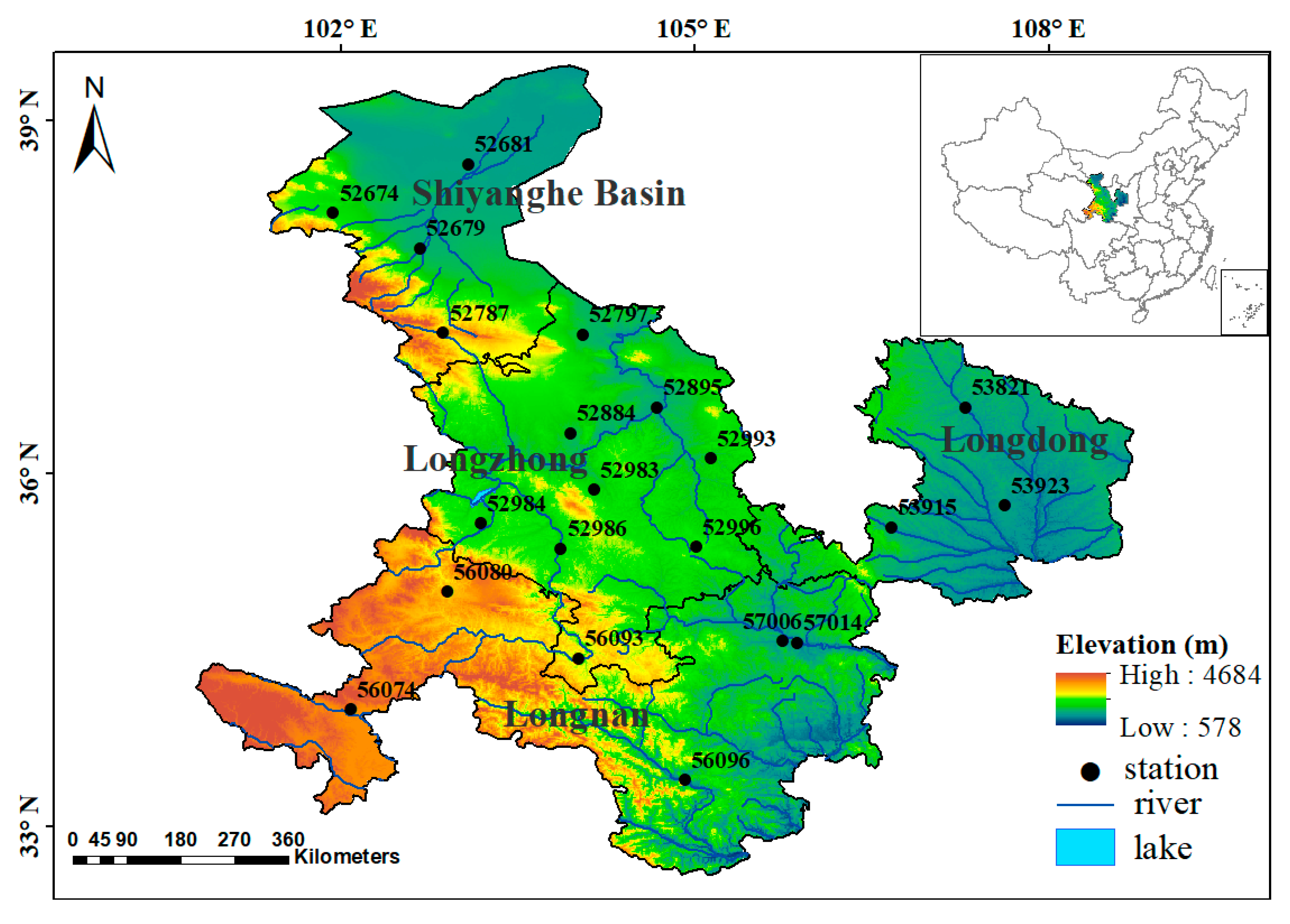
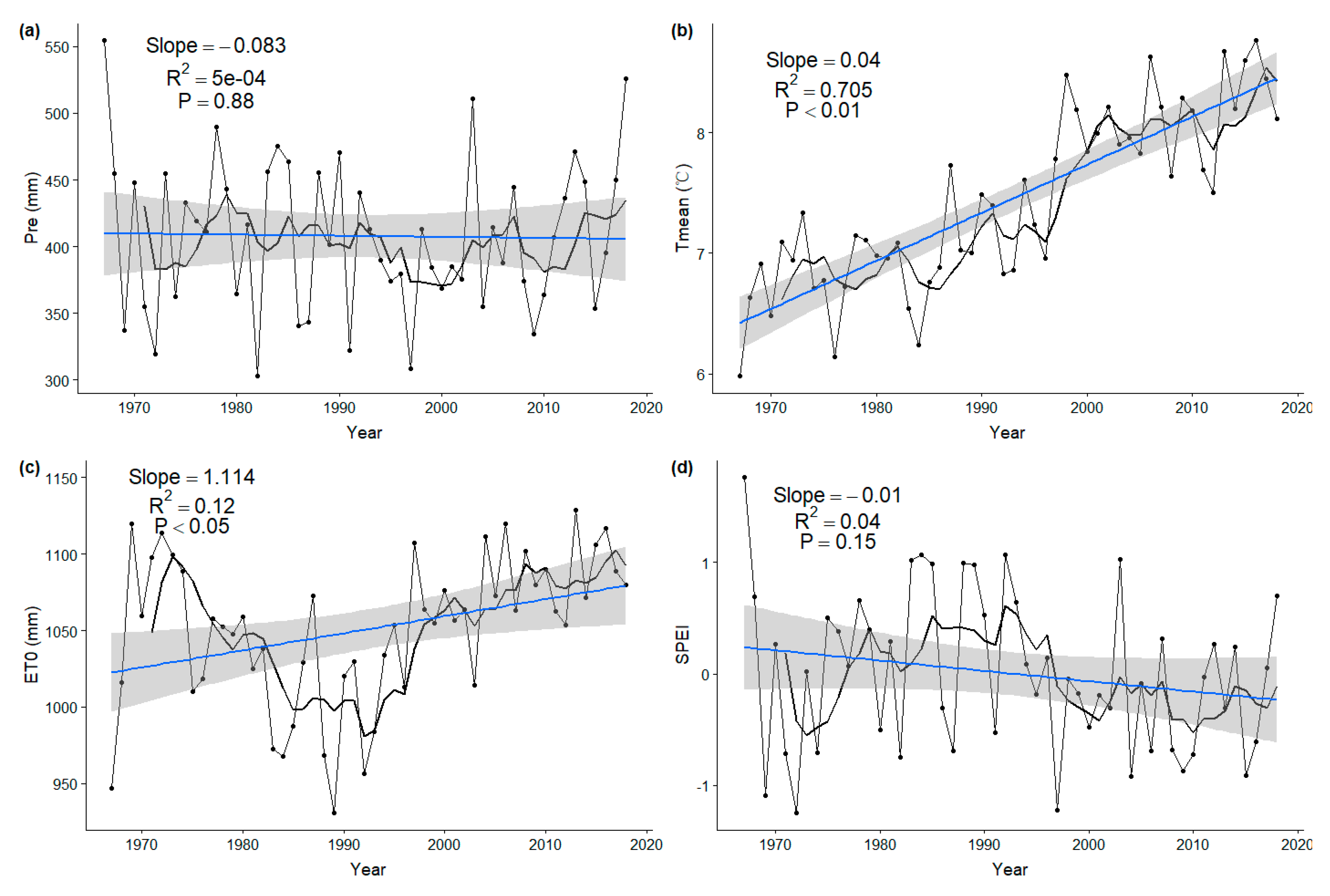
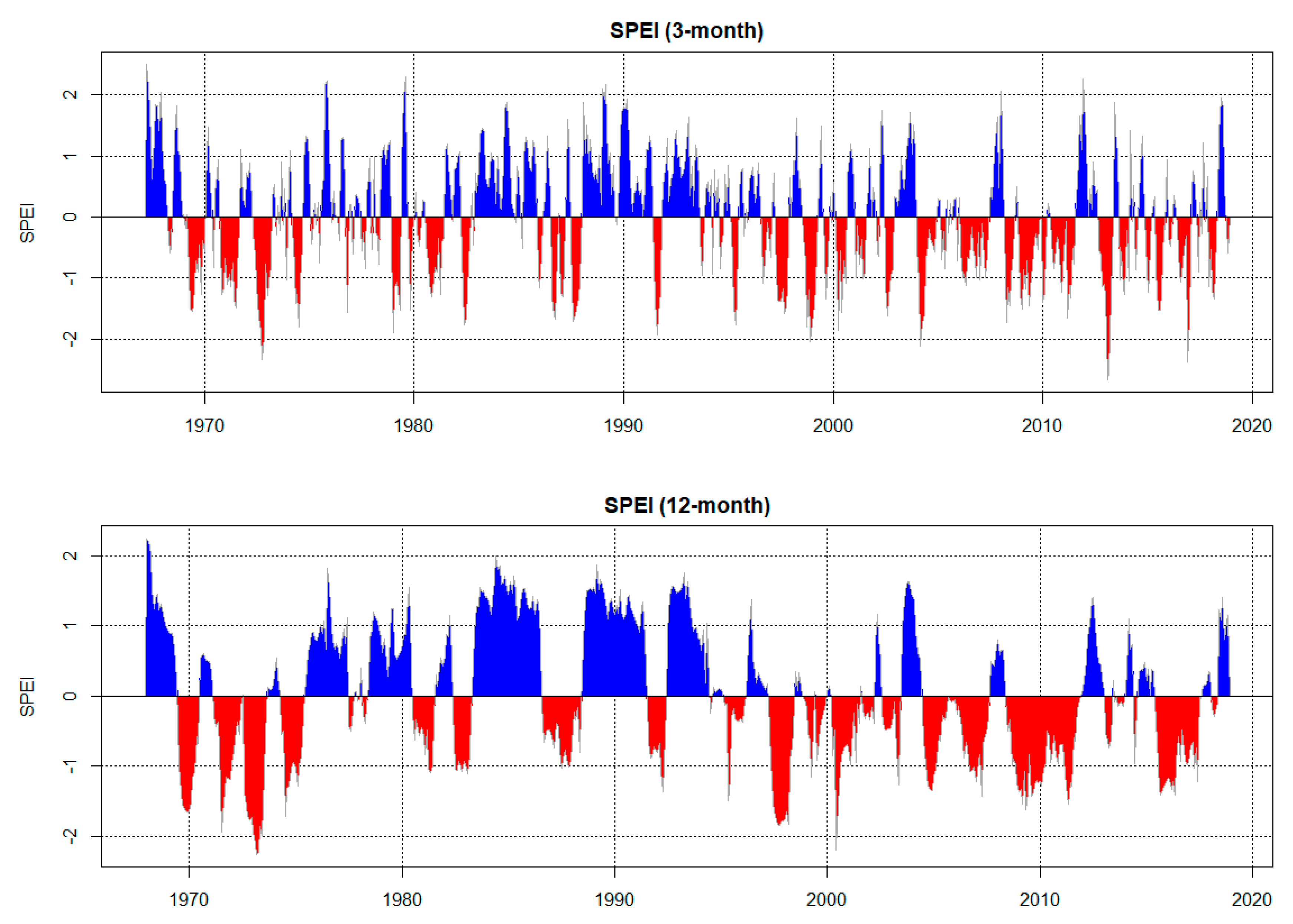
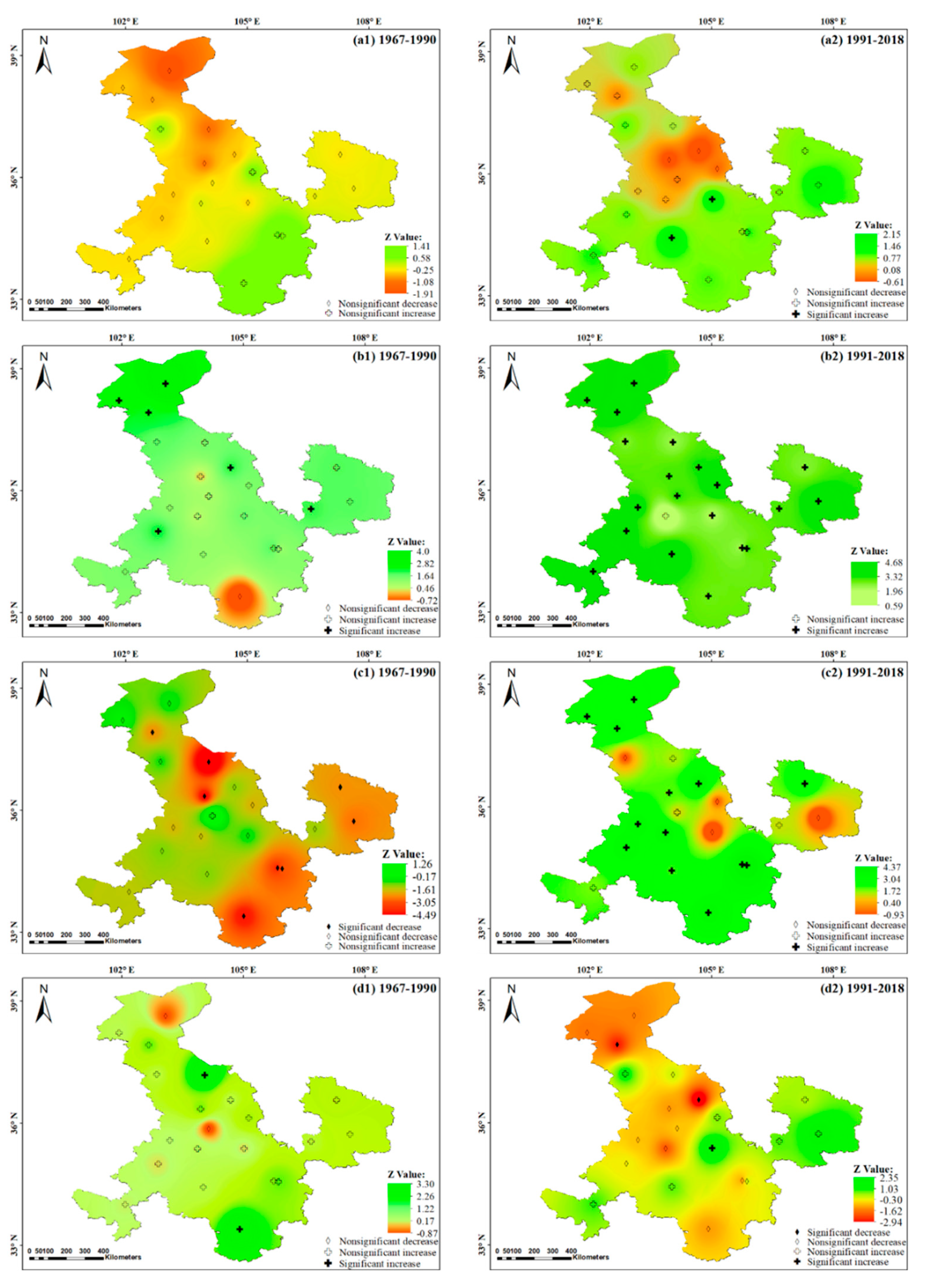
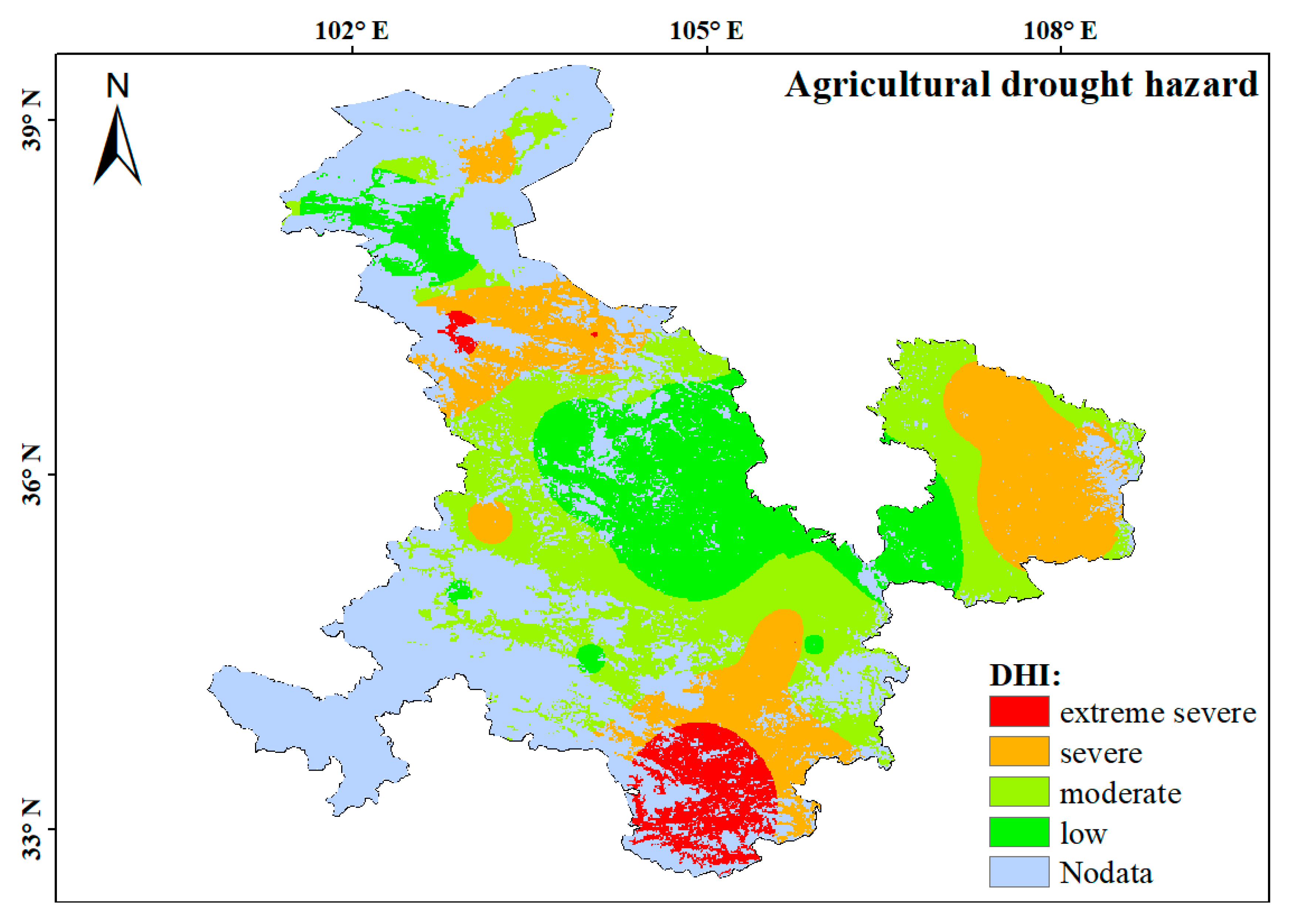
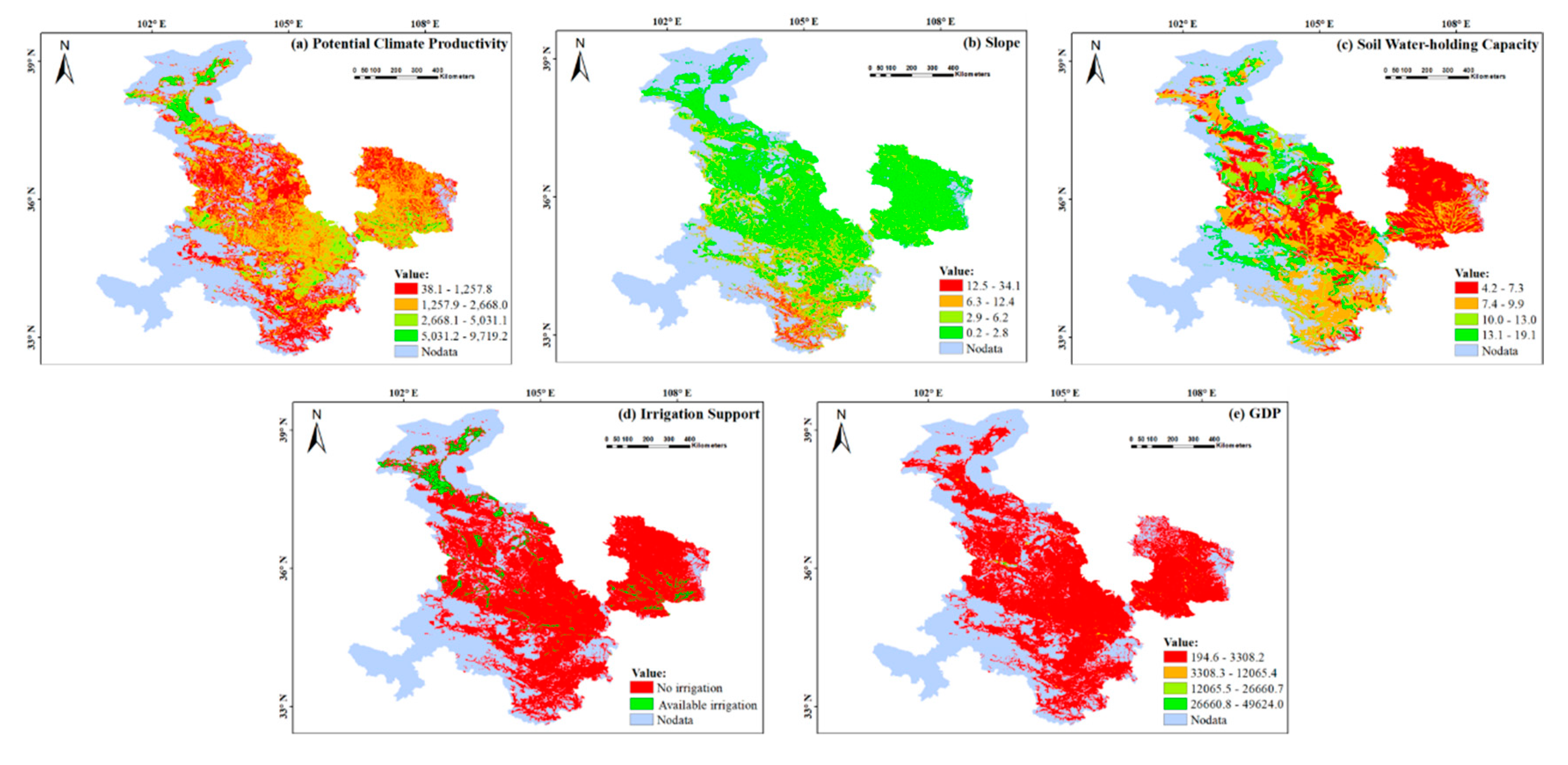
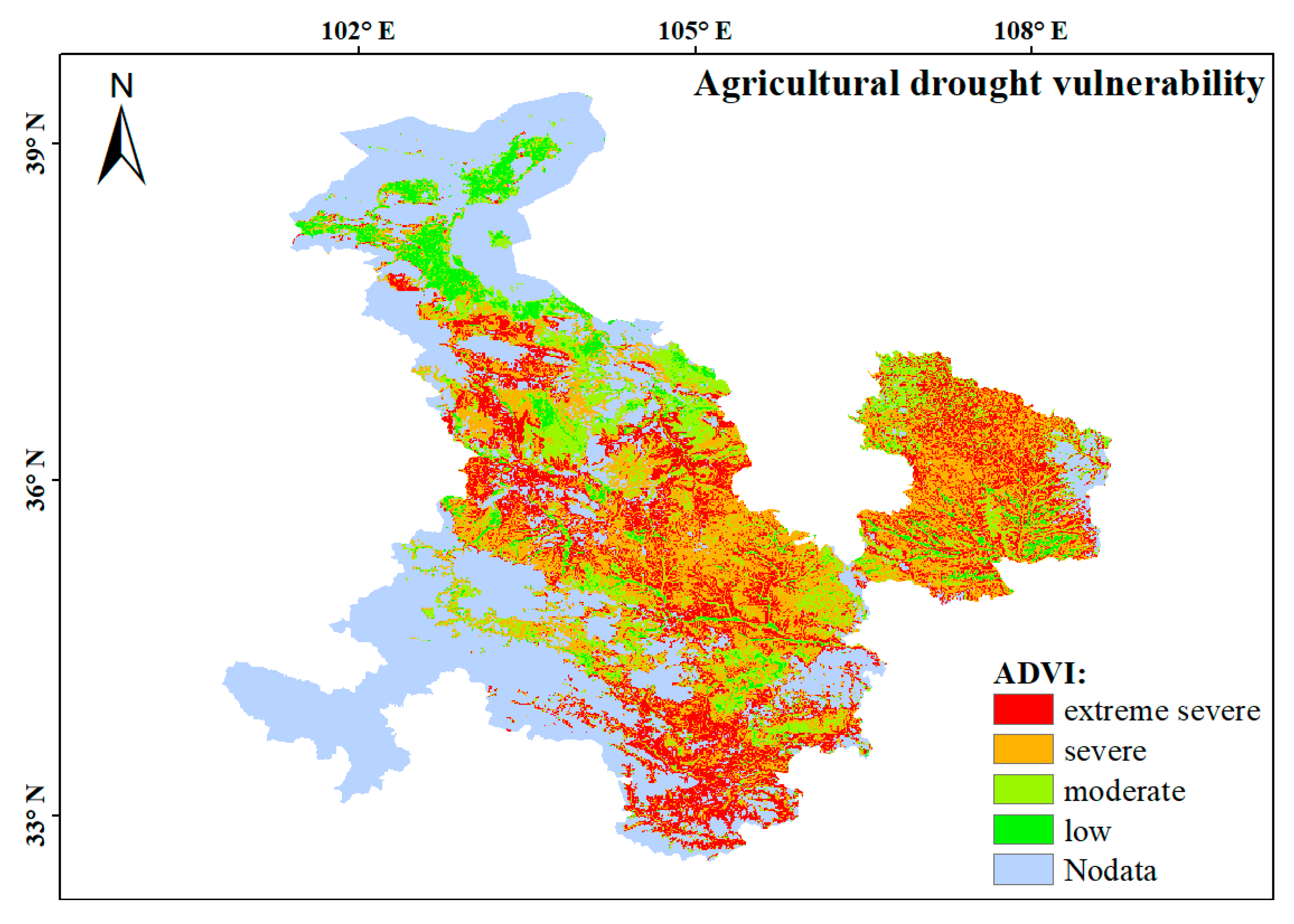
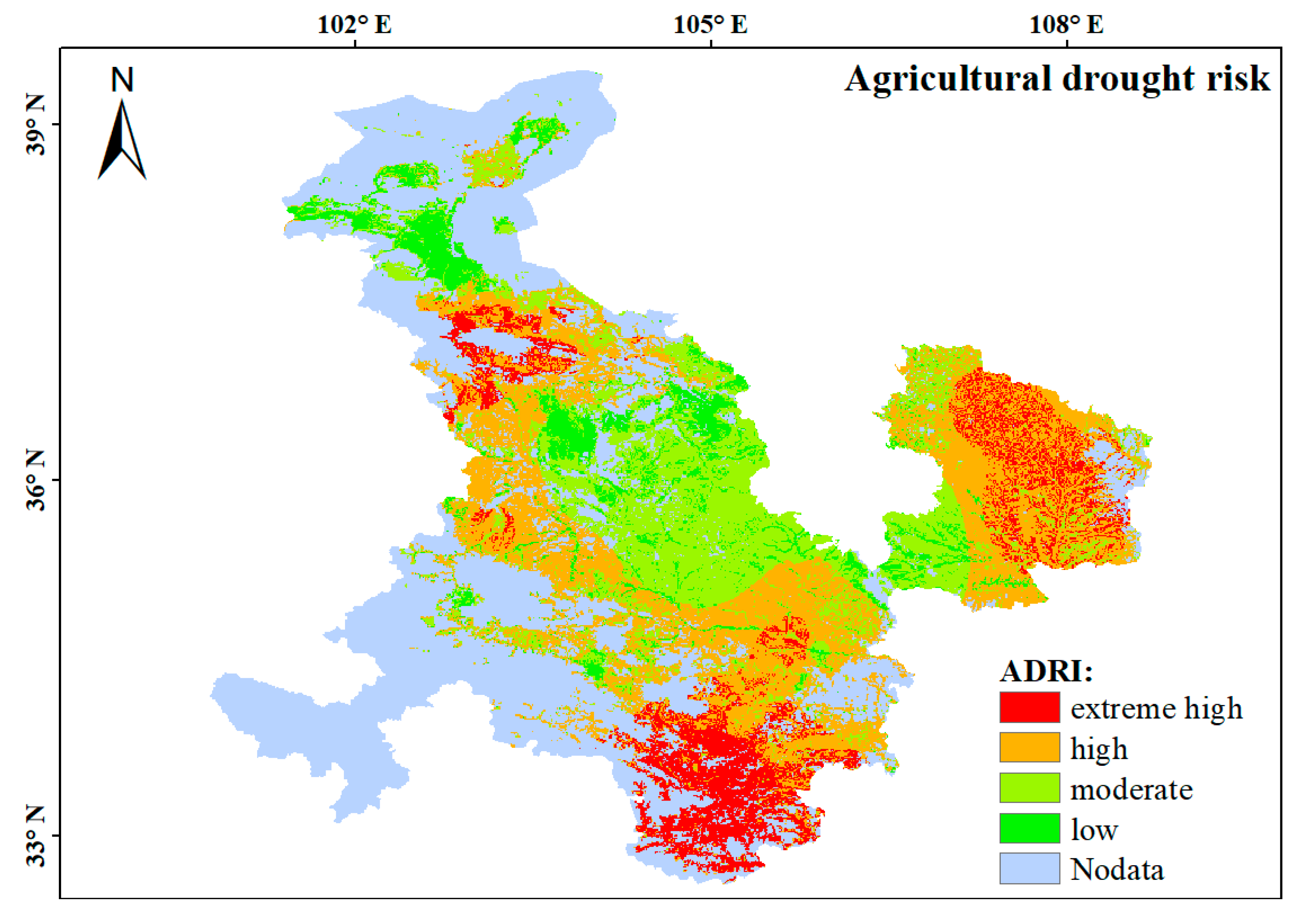
| Data set | Source |
|---|---|
| Data set of the monthly precipitation, sunshine duration, mean air temperature, maximum temperature, minimum temperature, relative humidity, and wind speed during the period from 1967 to 2018 from 21 rain-gauge stations in southeast Gansu province | National Meteorological Information Center (http://www.cma.gov.cn) |
| Data set of the gross domestic product at a kilometer scale in China | National Earth System Science Data Sharing Infrastructure (http://www.geodata.cn) |
| Data set of the irrigation types in China | |
| Data set of the altitudes in China (digital elevation model) | Resource and Environment Data Cloud Platform (http://www.resdc.cn) |
| Data set of the soil types in China Data set of potential farmland production in China |
| SPEI | Drought Intensity |
|---|---|
| (−1.0, 0] | Mild |
| (−1.5, −1.0] | Moderate |
| (−2.0, −1.5] | Severe |
| (−∞, −2] | Very severe |
© 2019 by the authors. Licensee MDPI, Basel, Switzerland. This article is an open access article distributed under the terms and conditions of the Creative Commons Attribution (CC BY) license (http://creativecommons.org/licenses/by/4.0/).
Share and Cite
Zeng, Z.; Wu, W.; Li, Z.; Zhou, Y.; Huang, H. Quantitative Assessment of Agricultural Drought Risk in Southeast Gansu Province, Northwest China. Sustainability 2019, 11, 5533. https://doi.org/10.3390/su11195533
Zeng Z, Wu W, Li Z, Zhou Y, Huang H. Quantitative Assessment of Agricultural Drought Risk in Southeast Gansu Province, Northwest China. Sustainability. 2019; 11(19):5533. https://doi.org/10.3390/su11195533
Chicago/Turabian StyleZeng, Zhaoqi, Wenxiang Wu, Zhaolei Li, Yang Zhou, and Han Huang. 2019. "Quantitative Assessment of Agricultural Drought Risk in Southeast Gansu Province, Northwest China" Sustainability 11, no. 19: 5533. https://doi.org/10.3390/su11195533
APA StyleZeng, Z., Wu, W., Li, Z., Zhou, Y., & Huang, H. (2019). Quantitative Assessment of Agricultural Drought Risk in Southeast Gansu Province, Northwest China. Sustainability, 11(19), 5533. https://doi.org/10.3390/su11195533





